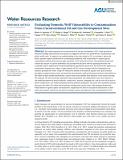| dc.contributor.author | Soriano, Mario A | |
| dc.contributor.author | Siegel, Helen G | |
| dc.contributor.author | Gutchess, Kristina M | |
| dc.contributor.author | Clark, Cassandra J | |
| dc.contributor.author | Li, Yunpo | |
| dc.contributor.author | Xiong, Boya | |
| dc.contributor.author | Plata, Desiree L | |
| dc.contributor.author | Deziel, Nicole C | |
| dc.contributor.author | Saiers, James E | |
| dc.date.accessioned | 2021-12-10T15:06:51Z | |
| dc.date.available | 2021-12-10T15:06:51Z | |
| dc.date.issued | 2020 | |
| dc.identifier.uri | https://hdl.handle.net/1721.1/138420 | |
| dc.description.abstract | © 2020. American Geophysical Union. All Rights Reserved. The rapid expansion of unconventional oil and gas development (UD), made possible by horizontal drilling and hydraulic fracturing, has triggered concerns over groundwater contamination and public health risks. To improve our understanding of the risks posed by UD, we develop a physically based, spatially explicit framework for evaluating groundwater well vulnerability to aqueous phase contaminants released from surface spills and leaks at UD well pad locations. The proposed framework utilizes the concept of capture probability and incorporates decision-relevant planning horizons and acceptable risks to support goal-oriented modeling for groundwater protection. We illustrate the approach in northeastern Pennsylvania, where a high intensity of UD activity overlaps with local dependence on domestic groundwater wells. Using two alternative models of the bedrock aquifer and a precautionary paradigm to integrate their results, we found that most domestic wells in the domain had low vulnerability as the extent of their modeled probabilistic capture zones were smaller than distances to the nearest existing UD well pad. We also found that simulated capture probability and vulnerability were most sensitive to the model parameters of matrix hydraulic conductivity, porosity, pumping rate, and the ratio of fracture to matrix conductivity. Our analysis demonstrated the potential inadequacy of current state-mandated setback distances that allow UD within the boundaries of delineated capture zones. The proposed framework, while limited to aqueous phase contamination, emphasizes the need to incorporate information on flow paths and transport timescales into policies aiming to protect groundwater from contamination by UD. | en_US |
| dc.language.iso | en | |
| dc.publisher | American Geophysical Union (AGU) | en_US |
| dc.relation.isversionof | 10.1029/2020WR028005 | en_US |
| dc.rights | Article is made available in accordance with the publisher's policy and may be subject to US copyright law. Please refer to the publisher's site for terms of use. | en_US |
| dc.source | Prof. Plata | en_US |
| dc.title | Evaluating Domestic Well Vulnerability to Contamination From Unconventional Oil and Gas Development Sites | en_US |
| dc.type | Article | en_US |
| dc.identifier.citation | Soriano, Mario A, Siegel, Helen G, Gutchess, Kristina M, Clark, Cassandra J, Li, Yunpo et al. 2020. "Evaluating Domestic Well Vulnerability to Contamination From Unconventional Oil and Gas Development Sites." Water Resources Research, 56 (10). | |
| dc.contributor.department | Massachusetts Institute of Technology. Department of Civil and Environmental Engineering | |
| dc.relation.journal | Water Resources Research | en_US |
| dc.eprint.version | Final published version | en_US |
| dc.type.uri | http://purl.org/eprint/type/JournalArticle | en_US |
| eprint.status | http://purl.org/eprint/status/PeerReviewed | en_US |
| dc.date.updated | 2021-12-10T15:02:00Z | |
| dspace.orderedauthors | Soriano, MA; Siegel, HG; Gutchess, KM; Clark, CJ; Li, Y; Xiong, B; Plata, DL; Deziel, NC; Saiers, JE | en_US |
| dspace.date.submission | 2021-12-10T15:02:04Z | |
| mit.journal.volume | 56 | en_US |
| mit.journal.issue | 10 | en_US |
| mit.license | PUBLISHER_POLICY | |
| mit.metadata.status | Authority Work and Publication Information Needed | en_US |
